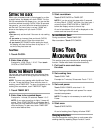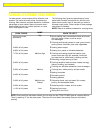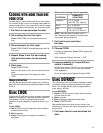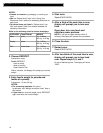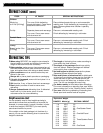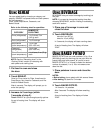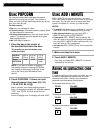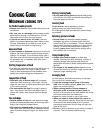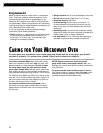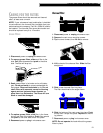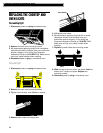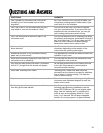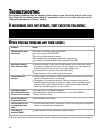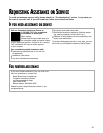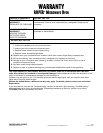
19
COOKING GUIDE
COOKING GUIDE
MICROWAVE COOKING TIPS
For the best cooking results
• Always cook food for the shortest cooking time rec-
ommended.
• Stir, turn over, or rearrange the food being cooked
about halfway through the cooking time. This will
help make sure the food is evenly cooked.
• If you do not have a cover for a dish, use wax
paper, or microwave-approved paper towels or plas-
tic wrap. Remember to turn back a corner of the
plastic wrap to vent steam during cooking.
Amount of food
• If you increase or decrease the amount of food you
prepare, the time it takes to cook that food will also
change. For example, if you double a recipe, add a
little more than half the original cooking time. Check
for doneness and, if necessary, add more time in
small increments.
Starting temperature of food
• The lower the temperature of the food being put into
the microwave oven, the longer it takes to cook.
Food at room temperature will be reheated more
quickly than food at refrigerator temperature.
Composition of food
• Food with a lot of fat and sugar will be heated
faster than food containing a lot of water. Fat and
sugar will also reach a higher temperature than water
in the cooking process.
• The more dense the food, the longer it takes to
heat. “Very dense” food like meat takes longer to
reheat than lighter, more porous food like sponge
cakes.
Size and shape
• Smaller pieces of food will cook faster than larger
pieces and same-shaped pieces of food cook more
evenly than irregularly shaped foods.
• With unevenly shaped foods, the thinner parts will
cook faster than the thicker areas. Place the thinner
parts of chicken wings and legs in the center of the
dish.
Stirring, turning foods
• Stirring and turning foods distributes heat quickly
to the center of the dish and avoids overcooking at
the outer edges of the food.
Covering food
Cover food to: reduce splattering, shorten
cooking times, and retain food moisture.
All coverings that allow microwaves to pass through
are suitable.
Releasing pressure in foods
• Several foods (for example: baked potatoes,
sausages, egg yolks, and some fruits) are tightly
covered by a skin or membrane. This can cause the
food to burst from steam building up in them during
cooking. To relieve the pressure and to prevent
bursting, pierce these foods before cooking with a
fork, cocktail pick, or toothpick.
Using standing time
•
Always allow food to stand for a while after
cooking. Standing time after defrosting, cooking, or
reheating always improves the result since the
temperature will then be evenly distributed throughout
the food.
• The length of the standing time depends on the
volume and density of the food. Larger, denser foods
require a longer standing time.
Arranging food
For best results, distribute food evenly on the plate.
You can do this in several ways:
• If you are cooking several items of the same
food, such as baked potatoes, place them in a ring
pattern for uniform cooking.
• When cooking foods of uneven shapes or
thickness, such as chicken breasts, place the
smaller or thinner area of the food towards the center
of the dish where it will be heated last.
• Layer thin slices of meat on top of each other.
• When you cook or reheat whole fish, score the
skin – this prevents cracking. Shield the tail and head
of whole fish with small pieces of foil to prevent
overcooking and ensure the foil does not touch the
sides of the oven.
• Do not let food or container touch the top or sides of
the oven. This will prevent possible arcing.



